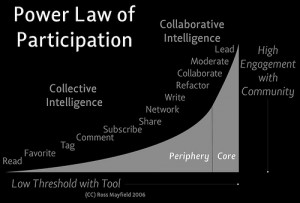We, Christian Crumlish, Lucas Pettinati and I, taught our Patterns Library workshop on Friday morning and I think it went really well. The feedback has been good so far and now I am very excited about taking the longer workshop to the IA Summit. We have more material and more exercises and ideas for more improvements from this teaching.
The networking and conversations as always was terrific and I met some great people and had really interesting conversations. Lots of people to follow up with over the next few weeks.
There were a handful of talks about patterns and it was part of the buzz over the weekend.
Luke Wroblewski talked about the Yahoo! homepage redesign, gave shout outs to me and my fellow pattern workshop leads and gave context for how his team used patterns in the redesign along with best practices and some core principles.
Ian Swinson from Salesforce.com presented Postcard Patterns: An Agile UI Pattern Creation Process. This was interesting to me because his description of their process and outcome in v1 I would not have called Patterns and they would have had more success had they taken our workshop. More like intense and more usable specs. But because they were specs they weren’t that usable or useful to designers working in the Agile Process. They ended up with 2 patterns after 6 months work. Not helpful. Their revamp had some interesting outcomes in that they started doing Pattern Blitzes where the team got together and wrote their patterns as a group in 2 hour sessions. There was lots knowledge sharing and crossover as items were discussed and this led to 43 or so patterns in a 3 month period. I think this is a very useful approach and have added the idea to our workshop in the how-to section. It looks they landed on something more usable in their environment and I am glad they shared both what worked and what didn’t.
From Core 77 – Jennifer Tidwell, an Interaction Designer at Google, presented a rapid, focused list of directives for good interface design for mobile device touchscreens. Standout suggestions: infinite lists, minimal headers (to avoid the “layer cake effect” of all header and no content), aggressive autocompletion (“because typing on a touchscreen pretty much always sucks”), and Share buttons everywhere (“mobile device use is inherently social”). Also, a commonly voiced concern: “What I worry about is the ghettoization of mobile design practices. We’re all going to be mobile designers soon enough. If you’re a web designer, chances aren’t bad you’re already doing it.”
Couldn’t agree more. It was great to see her thoughts about this. I was glad she presented these as works in progress for the community to offer thoughts and feedback about. Frankly I think that many of these patterns should just be amendments to their related web focused patterns as considerations about smaller interfaces and bandwidth differences.
A couple of other standouts were Christina Wodtke‘s talk about Viral applications. She didn’t present Patterns per se but more like high level principles to consider when developing social applications. These included:
- Make things Frictionless. The easier to do the more often people will do.
- Have important things At Hand. The more convenient and located near the primary object, the more likely to act on.
- Make it Impactful. Get the most bang for your buck or else why bother.
- Make sure it is Targeted. The wrong feature to the right people is as bad as the right feature to the wrong people. Build features for the most useful people.
- Have a plan for Outreach. Provide ways for others to share and distribute what you are doing in all the other places that matter.
The keynote speakers – at the beginning and end of each day – provide overarching inspirational and aspirational thoughts and challenged us as a design community to think bigger and broader than we might be doing individually or in our day to day. A lot of talk about green, about reaching out in this economy. My favorite though was when Kim Goodwin talked about mentoring. This is something much smaller than many of the others spoke about. It’s easily achievable and easily doable. Mentoring makes a huge impact to another person’s career and collectively can have a lot of impact on the industry as a whole. I felt that they were good words to end the conference on.
“Each one, teach one. Only in this way we may grow a sustainable profession.”
